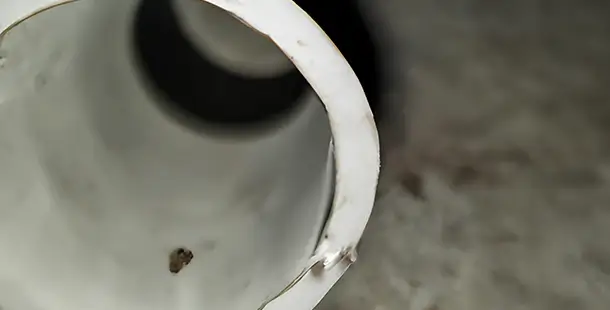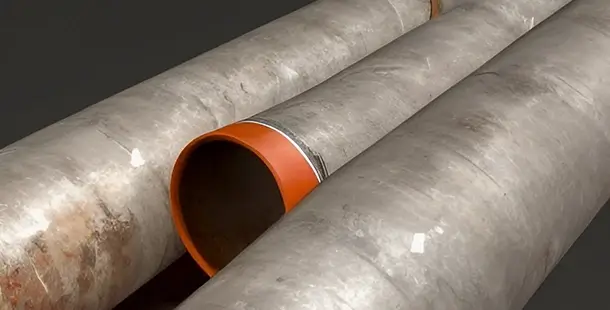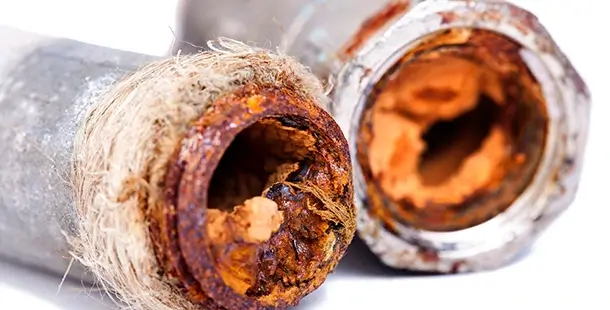Cured-in-Place Pipe Repair (CIPP)
Your home has aging pipes.
You know you should have them replaced — but repiping is expensive and disruptive. So you’ve been putting off the job, hoping for the best, and living on the edge of a plumbing disaster.
But what if you could cut your expenses in half and have the job finished in a day or two?
No digging? No tearing out walls? No disruption, other than a couple of days without water?
You may want to talk to us about CIPP: cured-in-place pipe lining. It makes old sewer pipes like new at about half the cost of repiping.

What Is Cured-in-Place Pipe (CIPP)?
CIPP rehabilitates old pipes with epoxy and mesh lining. It creates a new pipe within the old, extra strong and durable because the old pipe supports the new shell.
CIPP technology has existed in the United States for nearly four decades, but only recently has it gained a foothold.
Sewer lines are the usual targets of CIPP repair, but it also works for water lines and with most piping material, including clay, cast iron, galvanized steel, PVC, concrete, and corrugated metal.

How We Use CIPP to Reline a Damaged Pipe
Pipes in reasonably good condition are candidates for relining. What we mean by this is that a pipe can’t be so far gone it’s barely recognizable as a pipe, and it can’t have collapsed for its entire length!
But even with multiple points of collapse or complete blockage, we may be able to reline a damaged sewer pipe.
- We bore the pipe with cutting tools
- We clean out any remaining debris with a hydro jet
- We insert the epoxy sleeves, inflate them, and cure them in place

The CIPP Process in Detail
Cured-in-place piping uses liners made from tubular layers of polyester felt coated with polyurethane.
The liner must go through a wet-out process where the plumbing team inserts catalyzed thermosetting resin into the lining, coating the felt. This adds strength to the flexible lining until curing begins.
After wet-out, the liner travels by refrigerated truck to the repair location.
- The plumbers use water or air to “invert” the liner into the damaged pipe.
- A high-pressure air stream inflates the liner and presses it into the pipe walls (which is why CIPP won’t work in a pipe with little structure).
- Steam or hot water cures the resin, ensuring the liner stays open and adheres to the pipe walls.
- The plumbing team initiates a slow cooling process, ensuring the liner doesn’t contract. Contraction degrades the performance and life of the liner.
And just like that, the CIPP is complete.
The “liner” is exceptionally thick and strong, comparable to a new pipe.

Benefits of Cured-in-Place Pipe Lining
CIPP saves time and money. That’s the most obvious benefit and the usual reason why customers opt for CIPP repair.
In days of plumbing yore, the only way to replace damaged pipes was to dig them up, pull them out, and rebuild the piping system. It was a dirty and labor-intensive process that could take as long as several weeks. Customers were on the hook for labor, and replacement parts, and piping.
Traditional repiping is also highly disruptive. The building would be uninhabitable during the repair, forcing businesses to close and families to stay elsewhere. This would add pain and suffering to an already hefty bill.
CIPP with Orange Coast Plumbing
At Orange Coast Plumbing, we always take the most conservative and cost-effective approach possible, saving you money, time, and inconvenience.
Even if your pipes are ill-suited for CIPP, we may be able to use other trenchless methods.
Please call us if you’d like to know more. All consultations are free.

Frequently Asked Questions about Cured-in-Place Pipes
Is cured-in-place pipe lining durable?
Yes, CIPP is extremely durable and designed to last for up to 50 years with proper installation and care. The epoxy resin hardens quickly and forms a strong bond with your existing pipes that prevents leaks and breaks. Because CIPP lines are seamless, there are fewer points of failure than with traditional repiping methods. Furthermore, CIPP lines are resistant to corrosion from chemicals like chlorine which can cause other pipe materials to break down.
How thick is CIPP lining?
The CIPP liner tube may be single or multiple-layer construction with any layer not less than 1.5 mm thick. Liquid polyester resins or polyurethanes are used as coatings to provide extra strength and durability while curing takes place.
Is pipe relining worth it?
CIPP is a good investment because it’s less intrusive than repiping or pipe bursting, the end product has better quality, and you save money compared to other methods of repair.
Is cured-in-place pipe lining safe?
Yes, CIPP is considered safe for potable water systems because of the non-toxic materials used in the process. The epoxy resin liner meets US Environmental Protection Agency requirements for use in potable water applications. Additionally, a CIPP installation does not require any open flames or welding torches as with some traditional repiping methods.
Does pipe relining leave an odor?
No, you shouldn’t notice any odors after a successful relining. The epoxy resin is non-toxic and odorless. However, any odors in the pipes prior to relining still be present after the CIPP job is complete. A professional plumbing technician can help you determine the source of the odor and eradicate it.
Can cured-in-place pipe lining be used in any type of pipe?
Yes, CIPP can be used in almost any type of home or commercial piping system ranging from clay, cast iron, galvanized steel, PVC, concrete and corrugated metal. The flexibility of the epoxy resin combined with the special techniques used in installation allows the process to work on a variety of pipes and substrates.
What is the best way to care for cured-in-place pipes?
The best way to ensure your CIPP lasts as long as possible is to practice regular maintenance and upkeep on your plumbing system. Use strainers and screens to catch hair, food particles, and other debris that can clog your pipes. Avoid pouring grease or oils down the drain. Schedule maintenance checks with your plumbing service.
For more information or to schedule an appointment, please call us today.
